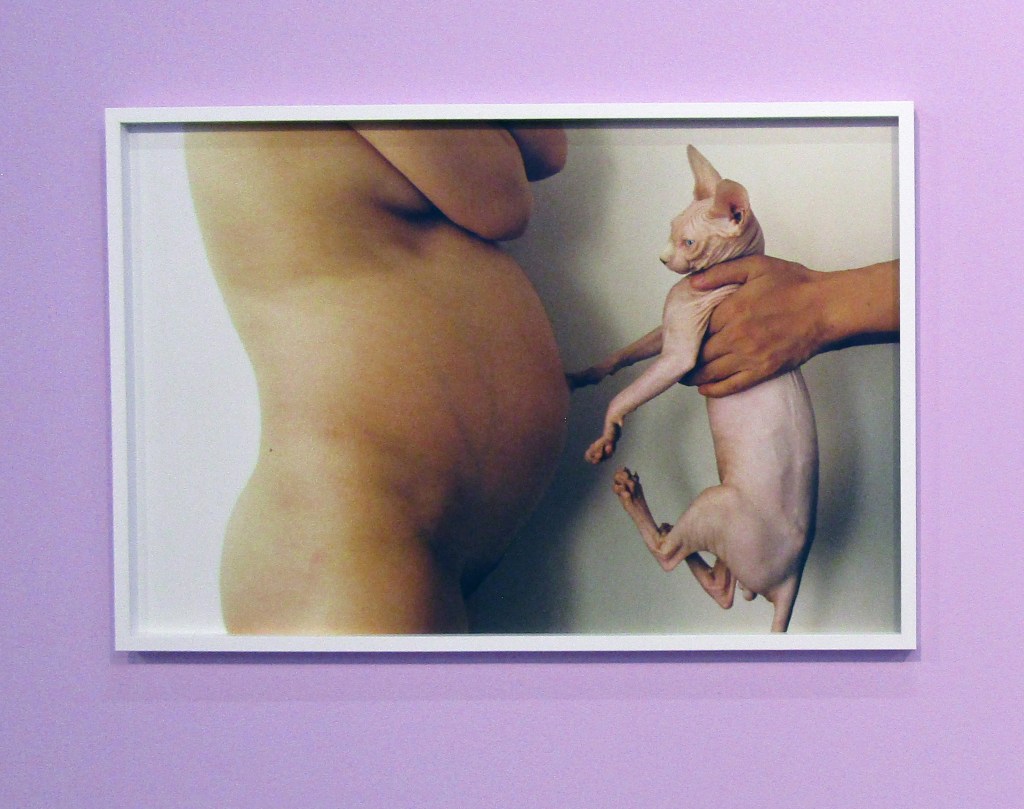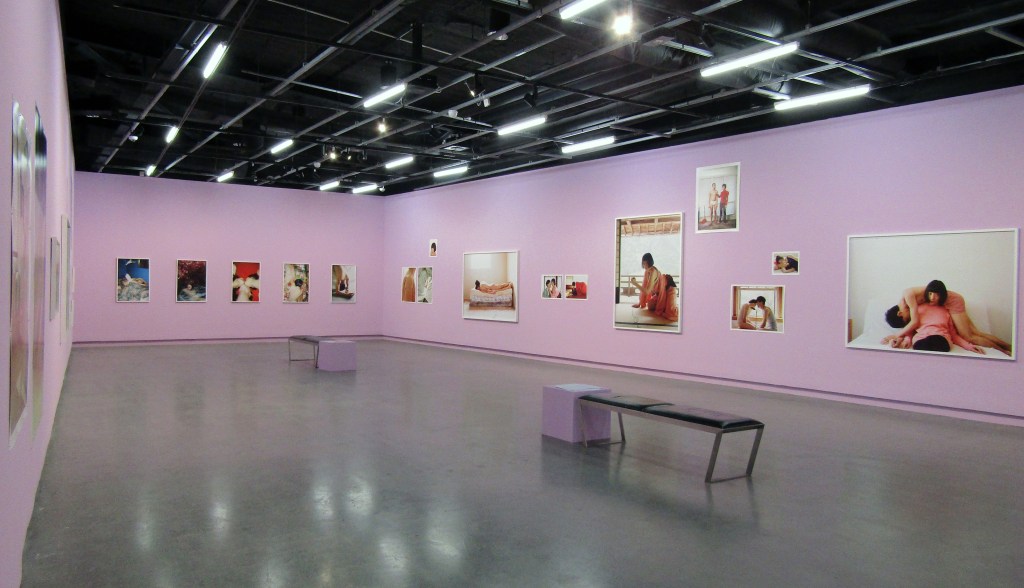Jump to:
Each, Other at Griffith University Art Museum (GUAM) may tantalise and titillate viewers with warm saturated colour and beautiful bodies in suggestive poses. But whether the photographs are perceived as profane or profoundly humanist may depend on the cultural lens used to view them. This abridged version of an exhibition that was held at the Art Gallery of Western Australia is curated by Rachel Cieśla and features the ascendant artists in the field of international art photography: Pixy Liao and Lin Zhipeng (aka No.223).
Pixy Liao
Residing in the US, Liao commenced challenging perceptions of Chinese women worldwide during her Master of Fine Arts (MFA) at the University of Memphis. Relationships work best when each partner knows their proper place (2008) is among the photographs made in her graduating year and included in this exhibition. A fully clothed Liao appears to signal to a Y-fronts clad Takahiro Morooka – Liao’s partner, also known as Moro – to activate the shutter by pinching his left nipple.
Not unlike Frank Uwe Laysiepen (aka Ulay)’s relationship with Marina Abramovic, Moro’s presence in Liao’s photographs is persistent. However, whereas the former was acknowledged as an artistic collaborator, Moro appears as a “prop”. Liao also shares the mechanics of her process with the audience by the use of a lengthy shutter release cable. In After Psyche Revived by Cupid’s Kiss (2019), Liao brandishes it like a whip above Moro, who is laid face down and bare in her lap.
In How to build a relationship with layered meanings (2008), Liao lies atop three mattresses, much like the protagonist in a modern day Princess and the Pea, with Moro draped over her. Completely passive in pose, his objectification could be suggestive of protection, like a blanket. Yet, at the same time, she is physically supporting his repose. These are discourses of dominance, which Liao engages to disrupt the diametrically opposing constructs of the subservient wife and the “dragon lady”.
Liao’s “selfies” document the development of her relationship with a Japanese man who is five years her junior. According to the artist, she and Moro are also an unlikely pairing due to remanent hostilities in China towards the nationals of its former occupier. The expectation of heterosexual pairings that the male should be older also retains currency in many cultures. It is in flouting these prejudices that her humour is highlighted.
Lin Zhipeng
While proliferating counternarratives were previously the domain of the arts, social media now presents an alternative avenue. Lin continues to straddle both, through profiles like ‘编号 [serial number] 223’ on Instagram. The name was taken from a protagonist in the Hong Kongese film Chungking Express. He uses the channels to capture a zeitgeist of abandonment among a generation of middle-class Chinese who refuse to conform to its values.
Likened to Nan Goldin, Lin began documenting his subculture using film and a “direct on-camera” flash in the mid-2000s. The growing ubiquity of digital technology adds gravitas to what may have otherwise been a small technicality. There is an immediacy and authenticity afforded by his engagement of “a pre-Photoshop” media, which has not been diminished through the processes of negative scanning and digital printing. Unlike Goldin’s photographs, a majority of Lin’s compositions appear to have been staged.
Among the earliest of the artworks in this exhibition is Scissors’ Narrative (2019). It appears to capture a moment of repose between female friends. The head of a woman rests in the crotch of the other. Lin, who is a former media editor and has flourished to become a prominent Beijing-based photographer and writer, graduated from the Guangdong University of Foreign Studies in Finance and English. Beginning with a blog titled North Latitude 23, Lin, similar to Nobuyoshi Araki, has proved to be a prodigious “point-and-shoot diarist”.
By experiencing the COVID lockdowns, audiences may have developed a greater understanding of the cloistered circumstances captured in Lin’s photographs. It is through this lens that the inventiveness of Mushroom Container (2020) may be appreciated. What appears to be a packet of shimeji mushrooms has been propagated in a pile of compost on the torso of a man lying in front of a window.
The props and positioning accentuate his male form as a landscape, echoing the ink drawings for which China is famed. Unlike Liao’s early treatment of Moro, the people photographed by Lin purportedly play an active role in negotiating their poses. Their subjecthood is emphasised by an engagement of domestic items drawn from the vicinity. These compositions exemplify the exercise of agency.

A uniquely panoptic perspective of being Chinese is presented in Each, Other through this interspersal of the raw and moderately raucous images of “youth” on the mainland, among the carefully conceived and immaculately executed self-portraits of a diasporic couple in the US. The intersection between private and public is, by definition, the domain of politics. They are inextricable from the conversation about an exhibition that features Chinese artists in this post-COVID era, when hostilities towards their people remain high. The Australian mainstream media appears rife with stories seeding distrust around China while, on the other hand, Chinese media censorship remains an issue. The exhibition may pose a pertinent question: Can individuals, offering a personal perspective on any society, prove more reliable narrators than “the state”?
Read: Book review: At the Foot of the Cherry Tree, Alli Parker
Irrespective, each and every viewer should relate to some aspects of the artwork. The exhibition examines universal themes, such as love and intimacy, using ubiquitous symbols like doves and flowers. If, by chance, these prove unfamiliar, then the process of using photographs to cultivate a profile via social media should strike a chord. However, to appreciate the humanism in this exhibition audiences may need to look beyond the ethnicity of the artists and their subjects. As opposed to otherness, viewers need to see the ordinariness of the material and materials that have been transformed.
Each, Other by Pixy Liao and Lin Zhipeng (aka No.223) is on view at Griffith University Art Museum (GUAM) until 3 February 2024. GUAM has suggested that parents exercise their own discretion when entering with children.
This review is published under the Amplify Collective, an initiative supported by The Walkley Foundation and made possible through funding from the Meta Australian News Fund.





